1996 Massey Ferguson 399, still going strong
Posted by Chris Graham on 15th September 2023
Chris Graham meets Richard Collishaw and his owned-from-new 1996 Massey Ferguson 399; a tractor that’s still earning its daily bread.
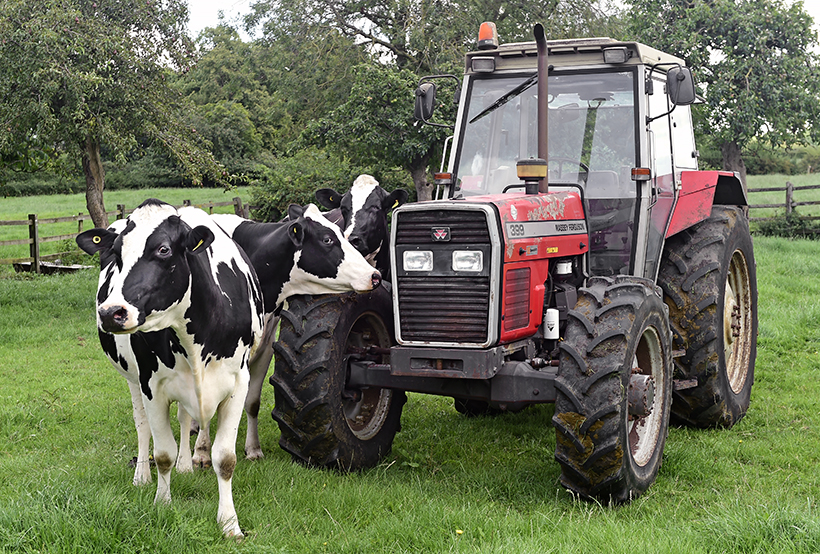
Massey Ferguson 399: Richard Collishaw has owned his 1996 MF 399 from new and, for many years, it played a key role in helping to manage his herd of pedigree Holstein Friesian dairy cows. Nowadays it leads an easier life, but isn’t quite ‘out to pasture’ yet!
I first met Richard Collishaw about a year ago, when I visited his Leicestershire dairy farm to photograph his superbly-restored MF 165. While we were chatting on that occasion, he happened to mention that he also owned a 1996 MF 399, which he’d had from new. He said that the tractor was very original, adding that it was still in everyday use on the farm and, as such, remained a valued member of the farm’s vehicle fleet.
Now, 12 months on, I’m back at Richard’s door, this time to find out more about his modern classic and why he’s become so attached to it. Back in the day, the 399 quickly developed a reputation for being a reliable, well-built all-rounder, and was available in both two-wheel and four-wheel-drive versions. It was in production at Banner Lane for 10 years from 1986, and so Richard’s machine is one of the last.
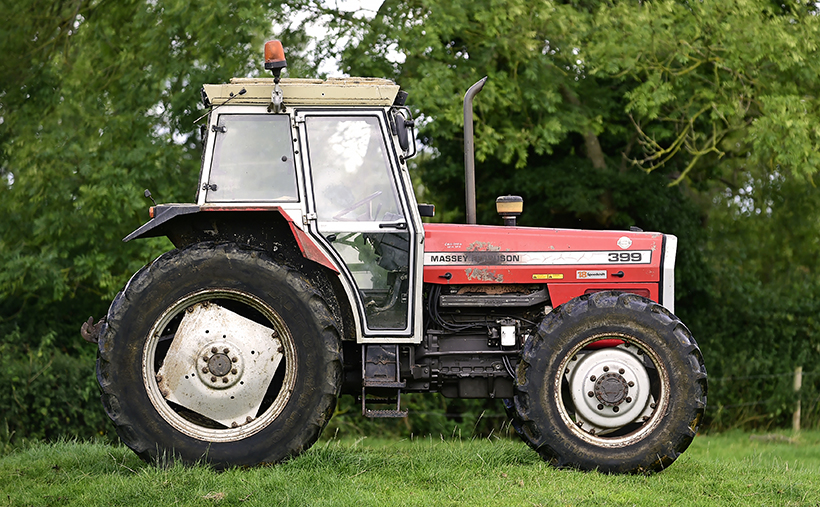
This is a late 399, with the 104hp Perkins six-potter, 4WD and a Hi-Line+ cab.
A rare survivor
Like all professional users, Richard has seen a steady flow of working tractors come and go as both his business and the market have changed. By and large there’s little room for sentiment when it comes to tractor ownership on a busy dairy farm; the machinery has to work reliably for its living and – especially nowadays – tractors are rarely kept for more than three years. However, for Richard, the MF 399 has proved to be an exception to the rule. It’s a tractor that’s managed to survive on the farm, despite the arrival of a succession of newer and superior MF models since the 1990s.
The Massey Ferguson 399 sat at the top of the very successful 300 Series range back in the mid-1990s, and was powered initially by a normally-aspirated, 97hp Perkins six-cylinder A6.354 diesel engine, although this was uprated in 1991 to an output of 104hp. It could be ordered with either a Hi-Line or a Lo-Line cab, and Richard’s is fitted with the former, as denoted by its flat floor.
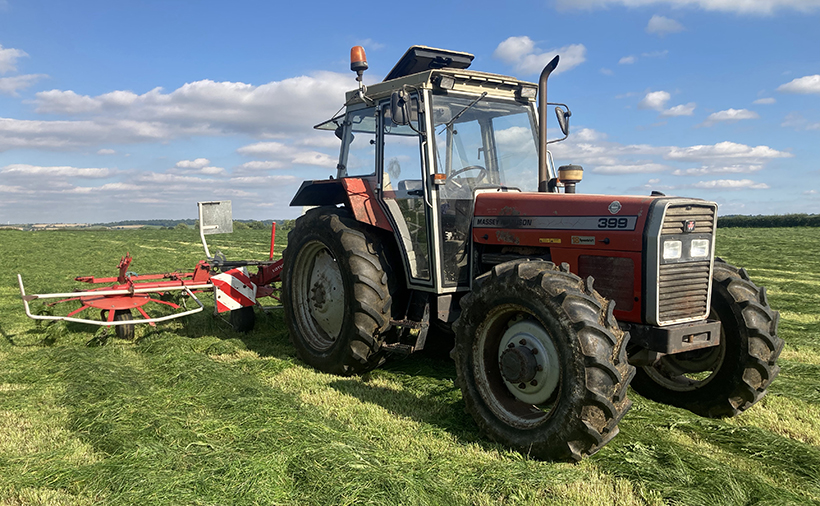
These days the tractor doesn’t get out into the fields as much as it used to, but here it is tedding some mown grass, using a Lely Lotus Stabilo. (Pic: Richard Collishaw)
Arriving on the farm early in 1997, the 339 was the first six-cylinder tractor Richard had owned, and he chose it because it seemed to be the most appropriate for his needs at the time. “I think that Massey Ferguson was producing the 3000 Series machines at the time, and those were the first of the ‘electronic’ models, with their Datatronic and Autotronic control and monitoring systems,” he recalled. “The 300 Series was probably the last of the MF ranges to be built without computer control and, in those days, it was marketed as more of a stockman’s tractor, which is why I went for the 399.
“It also represented a more cost-effective option at the time, and I do remember feeling some hesitancy towards the electronics side of things. Not only was I wary about the complexity of those new systems, but I was also conscious of the fact that, as a straightforward dairy operation, we didn’t have a need for the cutting-edge technology being offered on the 3000 Series models. All we required was a powerful, rugged and reliable 4WD tractor, and that’s what the MF 399 offered. The fact that it represented good value for money as well was simply an added bonus!”
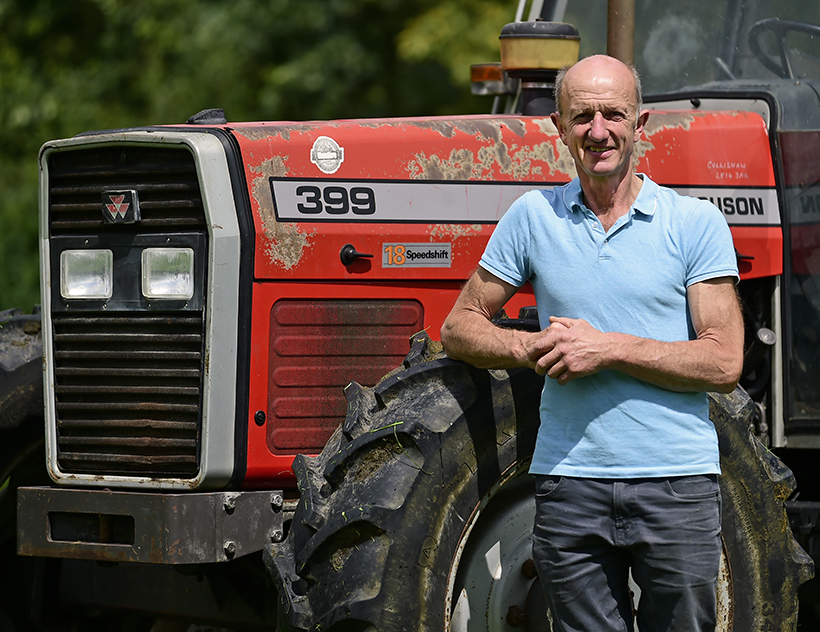
Richard Collishaw has developed quite an attachment to his MF 399, and now can’t see it ever leaving the farm.
A willing worker
“The tractor’s performance over the past 26 years has been superb, and I can honestly say that it’s never actually let me down. There have, of course, been a few gripes along the way, but none of them was serious and the tractor was never put out of action as a result. From day one here it tackled all the big jobs, such as silage-making and pulling a trailed forage harvester. It also did mowing, bale-carting, reversible ploughing, power-harrowing, drilling, rolling and a great deal of slurry-tankering. The farm produces a lot of slurry and, in those days, all of it was returned to the fields by us, which was heavy work. The 399 worked on those duties for many years, and took all of it in its stride.”
Nowadays the 399 is no longer one of the farm’s frontline machines but it, nevertheless, remains a very useful member of the mechanical team. “These days the tractor spends most of its working life attached to a Teagle straw-chopper,” Richard told me. “That machine converts five-foot, round-baled straw into 18mm chaff that’s used in the cow dairy cubicles. This process involves driving the tractor and chopper down between the rows of cubicles, so that the chopped straw being produced gets blown exactly where it’s needed. It carries out this routine work once a day, 365 days a year.”
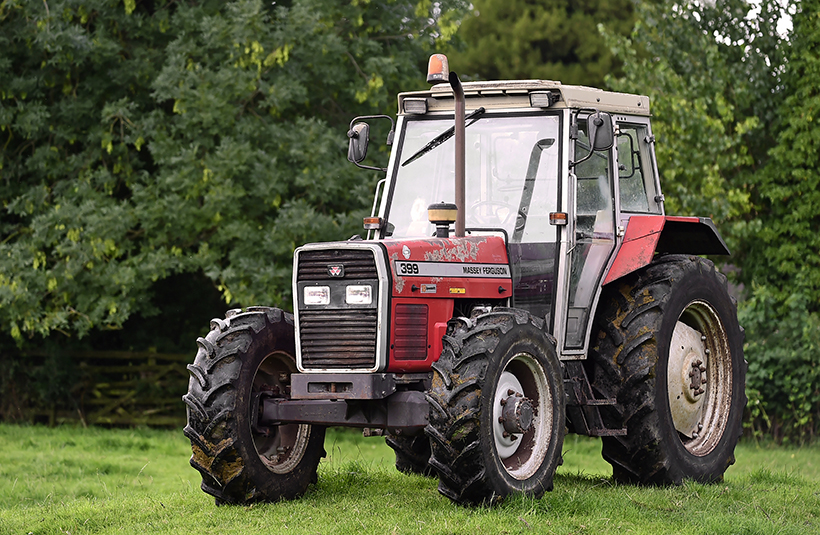
Richard is now very happy with the 399’s mechanical order. Sorting out the paintwork is a project for a later date.
Compared to its workload back in the day, it’s clear that the 399 is enjoying semi-retirement nowadays although, as Richard pointed out, what it does – although not especially taxing – remains essential work. “I’ve certainly developed a significant affection for the tractor which, I suppose, is why it’s still here. I’m very attached to it now and, while it’s a very different machine from my 1967 MF 165, it’s certainly grown on me over the years. It’s a tractor that’s worked tirelessly and well for me, and I appreciate both the quality and straightforward simplicity of its design. The fact that it comes from the pre-electronics era has, I think, contributed enormously to its steadfast reliability.”
Possible restoration?
The positive experience associated with Richard’s 165 restoration, and the pleasure he evidently gets from the finished machine, appear to have triggered some thoughts about doing something similar with the 399. “I’ve started thinking about how best to ensure the tractor’s longer-term future although, for as long as it remains a working machine, that won’t extend to a new paint job,” he said. However, he’s already had some mechanical work done.
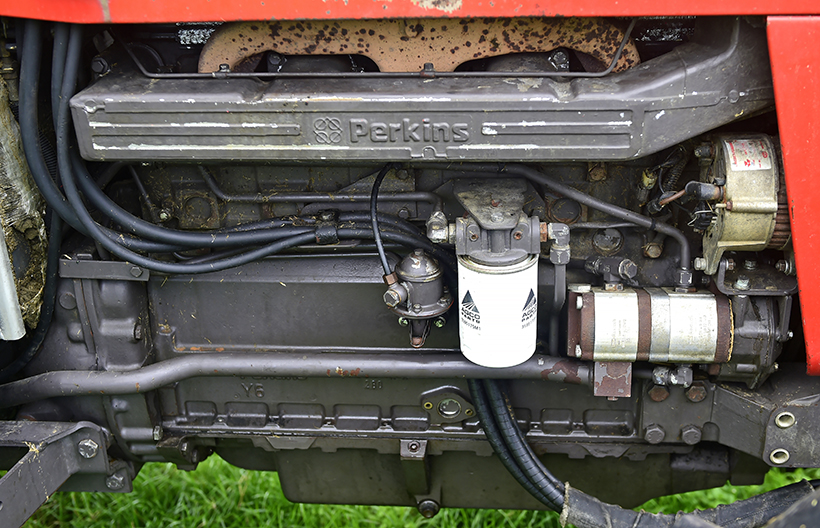
The Perkins engine, with about 7,000 hours on the clock, has been left untouched and runs as smoothly and reliably as when new.
“In 2021 I decided that it would be worth spending some money to bring it back up to scratch, mechanically speaking. I was aware that it was in need of some TLC; it was getting tired and, if I’m honest, it has been a little bit neglected in recent years. So I opted to engage the services of local Massey Ferguson specialist, Alan Faulks, who’d done so much great work on my 165. Happily, he agreed to help and, in August ’21, it went to his workshop for the process to begin.
“Such is Alan’s attention to detail, that he found more that needed doing than I was initially expecting. But I wanted it to be right mechanically, so was happy to be guided by him. In no particular order, the work carried out included fitting new king pin bearings in the front axle (which was also re-shimmed and bushed), replacing the timing cover on the engine, carrying out extensive repairs to the rear drawbar linkage assembly, fitting a new front driveshaft cover and replacing the quick-release ends on the hydraulic arms.

The soft trimming inside the cab has been replaced, as has the original seat. The Hi-Line+ cab features a flat floor although, overall, Richard finds it a touch cramped.
“Alan also fitted a new rocker cover gasket, replaced some of the rear wheel rim bolts, installed new battery leads and replaced the rubber gaiter at the bottom of the floor-mounted gear lever. In addition, a new fuel sender unit was fitted and, with regard to the electrical system, fuses and lights were replaced, as necessary. All the work was relatively cosmetic – including a full service – as the engine and running gear was still operating perfectly, so we saw no reason to go in any deeper with that. More recently, though, a new diaphragm clutch was fitted and Alan also installed an upholstery kit inside the cab. The original vinyl cladding panels – and the foam behind them – had become brittle and cracked.”
Future classic?
Chatting to Richard about the 399 generally, there’s little doubt that he feels the tractor has a great deal going for it. The model was a decent seller in its day, and he feels sure that many examples have survived and are still in regular use today. However, he admits to not having seen many at shows or auctions so far, so perhaps the model’s ascension to true classic status has yet to happen.

The only real signs of rust on this 27-year-old tractor are found along the bottom inside edges of the cab doors. A life lived mostly under cover has served overall condition well.
“Mechanically, the tractor’s now in good enough condition to warrant some fresh paint, but that would quickly get spoilt given that it remains a working machine. It does a dusty and sometimes messy job on a daily basis, so getting the tinwork sprayed at this stage just wouldn’t be worth it,” he told me.
“There’s a little bit of rust starting to bubble-up along the bottoms of the doors, but it’s not bad enough yet that I feel I need to do something about it. Elsewhere, the metalwork is in decent, original condition although, as you’ll see in the photographs, the paint has discoloured and is lifting on the side panels due, I think, to heat from the engine.
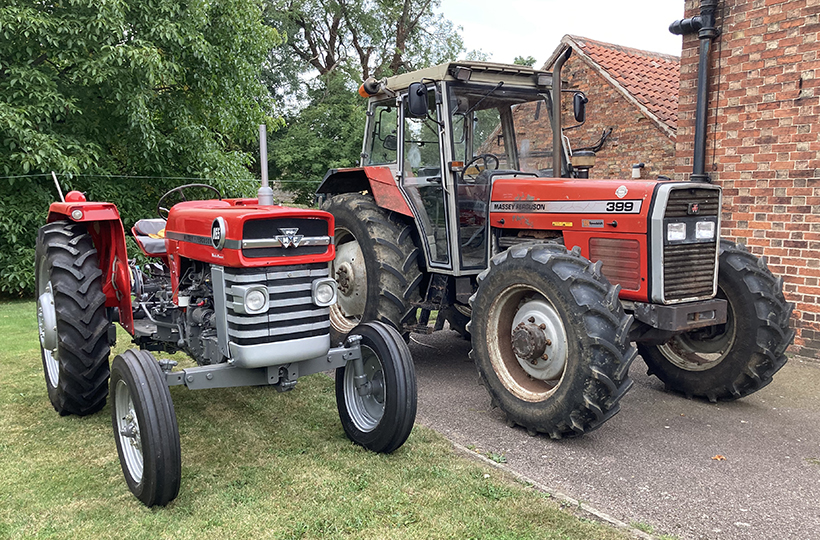
Richard’s pair of Massey Ferguson classics, with 29 years between them. (Pic: Richard Collishaw)
“Looking back over my time with the 399, the only real criticism I can level at it concerns the cab. I think it’s a bit small for the size of the tractor, and I believe that buyers of equivalent models from the contemporary 600 Series got a better working environment. However, I fully appreciate that the 399 was the more ‘basic’ option, so it’s probably not fair to grumble about that too much. It remains a comfortable tractor to use with excellent steering and visibility, and has served me superbly well in a hard, working environment for nearly three decades. You can’t really ask for much more than that!”
This feature comes from the latest issue of Classic Massey & Ferguson Enthusiast, and you can get a money-saving subscription to the magazine simply by clicking HERE

Previous Post
Protruck Auction at The Great Yorkshire Showground

Next Post
Joint 100th birthday celebrations for Welsh heritage railways



